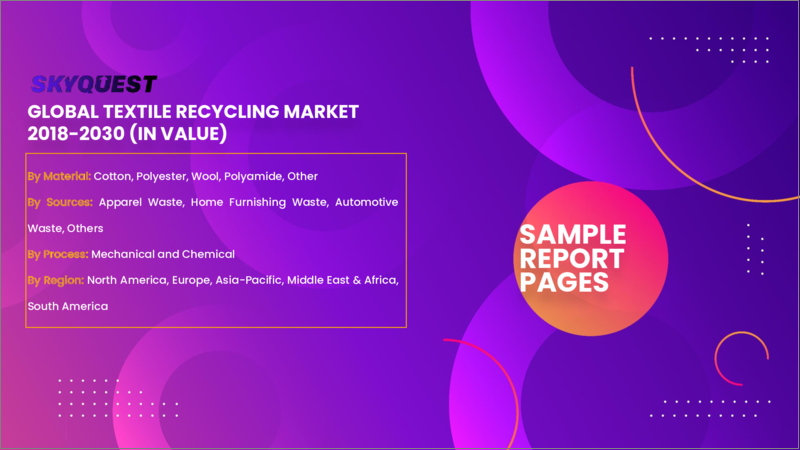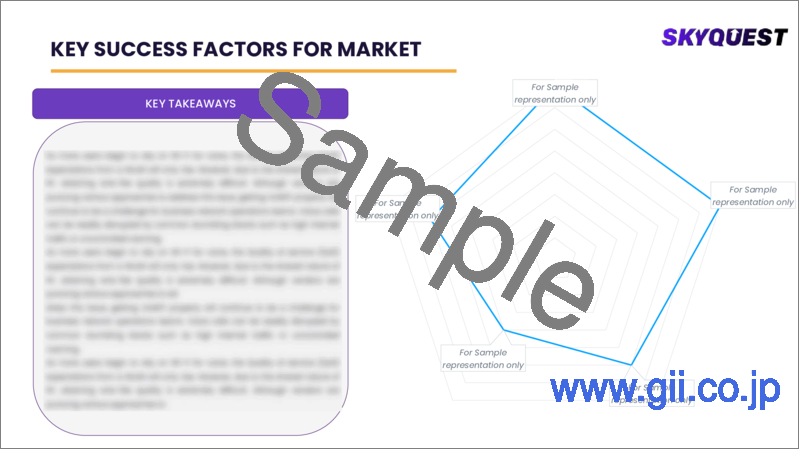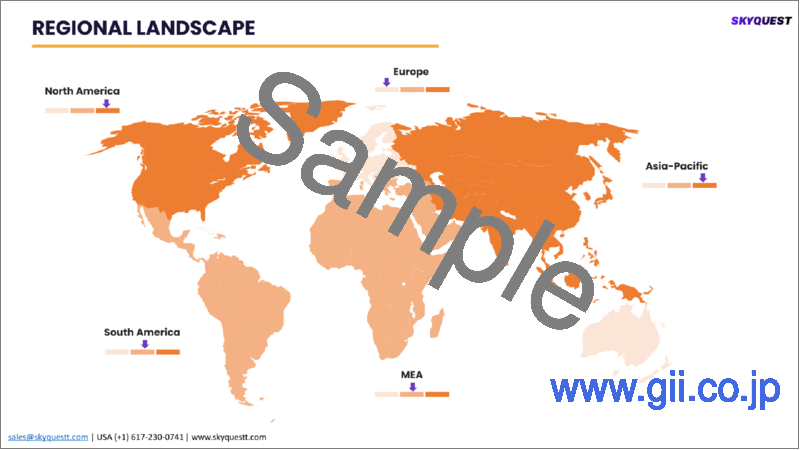|
|
市場調査レポート
商品コード
1345305
繊維リサイクルの世界市場 - 市場規模、シェア、成長分析:素材別(綿、ポリエステル)、由来別(アパレル廃棄物、家庭用家具廃棄物)、プロセス別(機械、化学) - 業界予測(2023年~2030年)Global Textile recycling market Size, Share, Growth Analysis, By Material(Cotton, Polyester), By Sources(Apparel Waste, Home Furnishing Waste), By Process(Mechanical and Chemical) - Industry Forecast 2023-2030 |
||||||
| 繊維リサイクルの世界市場 - 市場規模、シェア、成長分析:素材別(綿、ポリエステル)、由来別(アパレル廃棄物、家庭用家具廃棄物)、プロセス別(機械、化学) - 業界予測(2023年~2030年) |
|
出版日: 2023年07月29日
発行: SkyQuest
ページ情報: 英文 157 Pages
納期: 3~5営業日
|
- 全表示
- 概要
- 目次
世界の繊維リサイクルの市場規模は2021年に57億3,000万米ドルとなりました。同市場は、予測期間(2023年~2030年)に6.4%のCAGRで拡大し、2022年の61億米ドルから2030年には113億3,000万米ドルに成長する見通しです。
世界の繊維リサイクル市場は、主に環境意識の高まりと持続可能性への取り組みによって、近年大幅な成長を遂げています。繊維廃棄物やその環境への悪影響に対する懸念の高まりが、リサイクルソリューションへの需要を促進しています。市場では、機械的、化学的、熱的リサイクル方法など、繊維製品を効率的に再利用することを目的とした革新的な技術やプロセスが急増しています。さらに、いくつかの地域で繊維廃棄物処理に関する規制が厳しくなっていることも、市場拡大をさらに後押ししています。サーキュラーファッションの実践を促進するためのファッションブランドとリサイクル企業とのコラボレーションは、今後も市場の成長を促進し、持続可能な投資とビジネスチャンスをもたらす有望な分野となることが期待されます。
世界の繊維リサイクル市場は、いくつかの重要な要因によって牽引されています。第一に、環境意識の高まりと持続可能な実践への願望が、繊維リサイクルソリューションの需要増につながっています。消費者も企業も同様に、繊維廃棄物を減らし、ファッション産業が環境に与える影響を最小限に抑える必要性を認識しています。さらに、リサイクルと循環経済の原則を促進する規制措置が、繊維製品のリサイクル努力を後押ししています。さらに、メカニカルリサイクルやケミカルリサイクルなど、繊維リサイクルプロセスの技術的進歩が効率を高め、市場の可能性を拡大しています。最後に、古着ショッピングや古着市場の動向の高まりは、リサイクル用繊維製品の供給増加に寄与し、市場の成長とイノベーションを促進しています。
世界の繊維リサイクル市場は、その成長見通しを妨げるいくつかの重大な抑制要因に直面しています。まず、消費者や製造業者の間で、繊維リサイクルの環境面での利点に関する認識や教育が不足していることが、依然として大きな障害となっています。さらに、繊維産業の複雑なサプライチェーンと、多くの繊維製品に含まれるリサイクル不可能な素材の存在が、効率的なリサイクルプロセスにとって課題となっています。また、特定の地域では繊維製品の回収・リサイクル施設のインフラが限られていることも、市場の拡大を抑制しています。さらに、従来の繊維生産に比べてリサイクルに関連する収益性が相対的に低いことも、リサイクルの取り組みへの投資を抑制しています。こうした障壁を克服するには、繊維リサイクルをより実行可能で持続可能な産業にするため、教育、インフラ整備、技術の進歩において一致団結した取り組みが必要です。
当レポートは、世界の繊維リサイクル市場について調査し、市場の概要とともに、素材別、由来別、プロセス別、地域別の動向、および市場に参入する企業のプロファイルなどを提供しています。
目次
エグゼクティブサマリー
市場概要
親市場分析
市場概要
市場規模
- 市場力学
- 促進要因
- 機会
- 抑制要因
- 課題
- SWOT分析
主要な市場洞察
- 技術分析
- 価格分析
- サプライチェーン分析
- バリューチェーン分析
- 市場のエコシステム
- 知財分析
- 貿易分析
- スタートアップ分析
- 原材料分析
- イノベーションマトリックス
- パイプライン製品の分析
- マクロ経済指標
新型コロナウイルスの影響
市場力学と見通し
- 市場力学
- 促進要因
- 機会
- 抑制要因
- 課題
- 規制状況
- SWOT分析
- ポーターズ分析
市場規模、地域別
- 北米
- 欧州
- アジア太平洋
- ラテンアメリカ
- 中東・アフリカ
主要企業プロファイル
- 競合情勢
Global Textile recycling market size was valued at USD 5.73 billion in 2021 and is poised to grow from USD 6.10 billion in 2022 to USD 11.33 billion by 2030, growing at a CAGR of 6.4% in the forecast period (2023-2030).
The Global Textile Recycling Market has witnessed substantial growth in recent years, primarily driven by increasing environmental consciousness and sustainability initiatives. Growing concerns regarding textile waste and its adverse environmental impact have fueled demand for recycling solutions. The market has seen a surge in innovative technologies and processes aimed at efficiently repurposing textiles, including mechanical, chemical, and thermal recycling methods. Additionally, stringent regulations regarding textile waste disposal in several regions have further propelled market expansion. Collaboration between fashion brands and recycling firms to promote circular fashion practices is expected to continue driving the market's growth, making it a promising sector for sustainable investment and business opportunities.
Top-down and bottom-up approaches were used to estimate and validate the size of the Global Textile recycling Market and to estimate the size of various other dependent submarkets. The research methodology used to estimate the market size includes the following details: The key players in the market were identified through secondary research, and their market shares in the respective regions were determined through primary and secondary research. This entire procedure includes the study of the annual and financial reports of the top market players and extensive interviews for key insights from industry leaders such as CEOs, VPs, directors, and marketing executives. All percentage shares split, and breakdowns were determined by using secondary sources and verified through Primary sources. All possible parameters that affect the markets covered in this research study have been accounted for, viewed in extensive detail, verified through primary research, and analyzed to get the final quantitative and qualitative data.
Segments covered in this report:
The global adhesives and sealants market is segmented on the basis of material, source, process, and region. By Material, the market is segmented into Cotton, Polyester, Wool, Polyamide, Other. By Sources, the market is segmented into Apparel Waste, Home Furnishing Waste, Automotive Waste, Other. By Process industry, the market is segmented into Mechanical and Chemical. By region, the market is segmented into North America, Europe, Asia Pacific, Middle East and Africa, and Latin America.
Driver:
The global textile recycling market is being driven by several key factors. Firstly, growing environmental awareness and the desire for sustainable practices have led to increased demand for textile recycling solutions. Consumers and businesses alike are recognizing the need to reduce textile waste and minimize the environmental impact of the fashion industry. Additionally, regulatory measures promoting recycling and circular economy principles are incentivizing textile recycling efforts. Furthermore, technological advancements in textile recycling processes, such as mechanical and chemical recycling methods, are enhancing efficiency and expanding the market's potential. Finally, the rising trend of thrift shopping and second-hand clothing markets is contributing to the increased supply of textiles for recycling, fostering market growth and innovation.
Restraint:
The global textile recycling market faces several significant restraints that hinder its growth prospects. Firstly, the lack of awareness and education among consumers and manufacturers about the environmental benefits of textile recycling remains a major obstacle. Additionally, the textile industry's complex supply chain and the presence of non-recyclable materials in many textile products pose challenges for efficient recycling processes. Limited infrastructure for textile collection and recycling facilities in certain regions also restrains market expansion. Furthermore, the relatively low profitability associated with recycling compared to traditional textile production discourages investment in recycling initiatives. Overcoming these barriers will require concerted efforts in education, infrastructure development, and technology advancements to make textile recycling a more viable and sustainable industry.
Market Trends:
The global textile recycling market continues to witness robust growth, driven by increasing environmental awareness and the growing emphasis on sustainability within the textile industry. A shift in consumer preferences towards eco-friendly and circular fashion practices has spurred demand for textile recycling solutions. Furthermore, stringent regulations on waste management and disposal are pushing textile manufacturers to adopt recycling methods. Technological advancements in recycling processes, such as mechanical and chemical recycling, are enhancing the efficiency and viability of textile recycling. Additionally, collaborations between fashion brands and recycling companies are promoting the adoption of recycled textiles, fostering a circular economy. As a result, the global textile recycling market is poised for steady expansion in the coming years.
Table of Contents
Executive Summary
Market overview
- Exhibit: Executive Summary - Chart on Market Overview
- Exhibit: Executive Summary - Data Table on Market Overview
- Exhibit: Executive Summary - Chart on Global Textile recycling market Characteristics
- Exhibit: Executive Summary - Chart on Market by Geography
- Exhibit: Executive Summary - Chart on Market Segmentation
- Exhibit: Executive Summary - Chart on Incremental Growth
- Exhibit: Executive Summary - Data Table on Incremental Growth
- Exhibit: Executive Summary - Chart on Vendor Market Positioning
Parent Market Analysis
Market overview
Market size
- Market Dynamics
- Exhibit: Impact analysis of DROC, 2021
- Drivers
- Opportunities
- Restraints
- Challenges
- SWOT Analysis
KEY MARKET INSIGHTS
- Technology Analysis
- (Exhibit: Data Table: Name of technology and details)
- Pricing Analysis
- (Exhibit: Data Table: Name of technology and pricing details)
- Supply Chain Analysis
- (Exhibit: Detailed Supply Chain Presentation)
- Value Chain Analysis
- (Exhibit: Detailed Value Chain Presentation)
- Ecosystem Of the Market
- Exhibit: Parent Market Ecosystem Market Analysis
- Exhibit: Market Characteristics of Parent Market
- IP Analysis
- (Exhibit: Data Table: Name of product/technology, patents filed, inventor/company name, acquiring firm)
- Trade Analysis
- (Exhibit: Data Table: Import and Export data details)
- Startup Analysis
- (Exhibit: Data Table: Emerging startups details)
- Raw Material Analysis
- (Exhibit: Data Table: Mapping of key raw materials)
- Innovation Matrix
- (Exhibit: Positioning Matrix: Mapping of new and existing technologies)
- Pipeline product Analysis
- (Exhibit: Data Table: Name of companies and pipeline products, regional mapping)
- Macroeconomic Indicators
COVID IMPACT
- Introduction
- Impact On Economy-scenario Assessment
- Exhibit: Data on GDP - Year-over-year growth 2016-2022 (%)
- Revised Market Size
- Exhibit: Data Table on Global Textile recycling market size and forecast 2021-2027 ($ million)
- Impact Of COVID On Key Segments
- Exhibit: Data Table on Segment Market size and forecast 2021-2027 ($ million)
- COVID Strategies By Company
- Exhibit: Analysis on key strategies adopted by companies
MARKET DYNAMICS & OUTLOOK
- Market Dynamics
- Exhibit: Impact analysis of DROC, 2021
- Drivers
- Opportunities
- Restraints
- Challenges
- Regulatory Landscape
- Exhibit: Data Table on regulation from different region
- SWOT Analysis
- Porters Analysis
- Competitive rivalry
- Exhibit: Competitive rivalry Impact of key factors, 2021
- Threat of substitute products
- Exhibit: Threat of Substitute Products Impact of key factors, 2021
- Bargaining power of buyers
- Exhibit: buyers bargaining power Impact of key factors, 2021
- Threat of new entrants
- Exhibit: Threat of new entrants Impact of key factors, 2021
- Bargaining power of suppliers
- Exhibit: Threat of suppliers bargaining power Impact of key factors, 2021
- Skyquest special insights on future disruptions
- Political Impact
- Economic impact
- Social Impact
- Technical Impact
- Environmental Impact
- Legal Impact
Market Size by Region
- Chart on Market share by geography 2021-2027 (%)
- Data Table on Market share by geography 2021-2027(%)
- North America
- Chart on Market share by country 2021-2027 (%)
- Data Table on Market share by country 2021-2027(%)
- USA
- Exhibit: Chart on Market share 2021-2027 (%)
- Exhibit: Market size and forecast 2021-2027 ($ million)
- Canada
- Exhibit: Chart on Market share 2021-2027 (%)
- Exhibit: Market size and forecast 2021-2027 ($ million)
- Europe
- Chart on Market share by country 2021-2027 (%)
- Data Table on Market share by country 2021-2027(%)
- Germany
- Exhibit: Chart on Market share 2021-2027 (%)
- Exhibit: Market size and forecast 2021-2027 ($ million)
- Spain
- Exhibit: Chart on Market share 2021-2027 (%)
- Exhibit: Market size and forecast 2021-2027 ($ million)
- France
- Exhibit: Chart on Market share 2021-2027 (%)
- Exhibit: Market size and forecast 2021-2027 ($ million)
- UK
- Exhibit: Chart on Market share 2021-2027 (%)
- Exhibit: Market size and forecast 2021-2027 ($ million)
- Rest of Europe
- Exhibit: Chart on Market share 2021-2027 (%)
- Exhibit: Market size and forecast 2021-2027 ($ million)
- Asia Pacific
- Chart on Market share by country 2021-2027 (%)
- Data Table on Market share by country 2021-2027(%)
- China
- Exhibit: Chart on Market share 2021-2027 (%)
- Exhibit: Market size and forecast 2021-2027 ($ million)
- India
- Exhibit: Chart on Market share 2021-2027 (%)
- Exhibit: Market size and forecast 2021-2027 ($ million)
- Japan
- Exhibit: Chart on Market share 2021-2027 (%)
- Exhibit: Market size and forecast 2021-2027 ($ million)
- South Korea
- Exhibit: Chart on Market share 2021-2027 (%)
- Exhibit: Market size and forecast 2021-2027 ($ million)
- Rest of Asia Pacific
- Exhibit: Chart on Market share 2021-2027 (%)
- Exhibit: Market size and forecast 2021-2027 ($ million)
- Latin America
- Chart on Market share by country 2021-2027 (%)
- Data Table on Market share by country 2021-2027(%)
- Brazil
- Exhibit: Chart on Market share 2021-2027 (%)
- Exhibit: Market size and forecast 2021-2027 ($ million)
- Rest of South America
- Exhibit: Chart on Market share 2021-2027 (%)
- Exhibit: Market size and forecast 2021-2027 ($ million)
- Middle East & Africa (MEA)
- Chart on Market share by country 2021-2027 (%)
- Data Table on Market share by country 2021-2027(%)
- GCC Countries
- Exhibit: Chart on Market share 2021-2027 (%)
- Exhibit: Market size and forecast 2021-2027 ($ million)
- South Africa
- Exhibit: Chart on Market share 2021-2027 (%)
- Exhibit: Market size and forecast 2021-2027 ($ million)
- Rest of MEA
- Exhibit: Chart on Market share 2021-2027 (%)
- Exhibit: Market size and forecast 2021-2027 ($ million)
KEY COMPANY PROFILES
- Competitive Landscape
- Total number of companies covered
- Exhibit: companies covered in the report, 2021
- Top companies market positioning
- Exhibit: company positioning matrix, 2021
- Top companies market Share
- Exhibit: Pie chart analysis on company market share, 2021(%)




